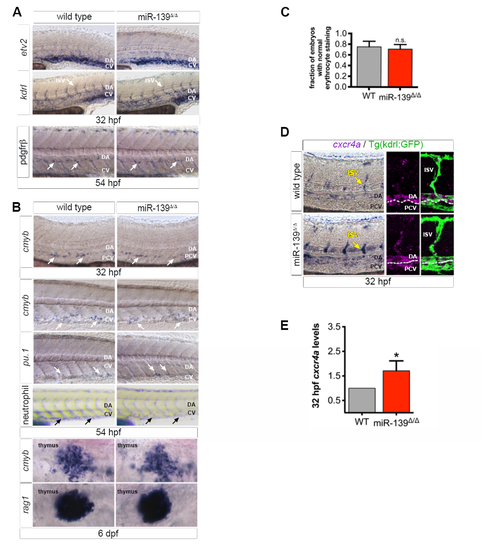Fig. S3
|
miR-139 does not regulate vessel outgrowth or flow-responsive processes (related to Figure 3). (A) WISH for angiogenesis markers etv2 and kdrl and smooth muscle cell marker pdgfrβ. No differences were noted in mutant embryos. (B) pu.1+ progenitors, sudan black stained neutrophils, and erythrocytes (C, below) were used to mark the myeloid hematopoietic lineage. rag1 marks lymphocytes. Blood production was unaffected in mutant embryos. (C) miR-139 target genes were enriched for erythrocyte development GO terms (Figure 2F), so we quantified the fraction of embryos with normal o-dianisidine staining of erythrocytes. Erythrocyte levels were not statistically different (n.s., p > 0.05) to wild type embryos at 54 hpf by two-tailed Mann-Whitney U-test. Bars show mean + SEM (D)WISH of vascular angiogenesis marker cxcr4a in wild type and mutant embryos. Yellow arrows in images (left) point to the ISVs captured in confocal projections that show cxcr4a within the lateral Kdrl:GFP+ trunk vasculature (middle, right). (E) Average fold expression of cxcr4a mRNA in miR-139Δ/Δ tails normalized to actb1 and relative to wild type tails at 32 hpf as determined by qRT-PCR for 5 biological replicates. Notably, the increase in cxcr4a expression does not result from a moderate disruption in blood flow (Packham et al., 2009) as flow-dependent formation of of cmyb+ HSPCs (North et al., 2009) and descending hematopoietic lineages were unaffected in miR-139Δ/Δ embryos (B-C). Bars indicate mean + SEM. *p ≤ 0.05, Student’s test For all images, arrows indicate representative staining and developmental stages are as indicated (n = 10-20 embryos). |
Reprinted from Developmental Cell, 40, Kasper, D.M., Moro, A., Ristori, E., Narayanan, A., Hill-Teran, G., Fleming, E., Moreno-Mateos, M., Vejnar, C.E., Zhang, J., Lee, D., Gu, M., Gerstein, M., Giraldez, A., Nicoli, S., MicroRNAs Establish Uniform Traits during the Architecture of Vertebrate Embryos, 552-565.e5, Copyright (2017) with permission from Elsevier. Full text @ Dev. Cell

